Women’s Leadership in Sustainable Agriculture: Preserving Traditional Knowledge Through Home Gardens in Santa Maria Jacatepec, Oaxaca
Abstract
1. Introduction
2. Materials and Methods
2.1. Study Site Location
2.2. Research Design
2.2.1. Household Surveys
2.2.2. Interviews and Focus Groups
2.2.3. Food Security and Economic Data
2.2.4. Crowdfunding Experiment
2.3. Data Analysis
3. Results and Discussion
3.1. Evaluation of the Conceptual Model for Home Garden Adoption and Community Engagement
3.1.1. Stage One: Organizational Foundations
3.1.2. Stage Two: Inclusive Planning and Strategy Development
3.1.3. Stage Three: Implementation and Community Empowerment
3.2. Impact of Home Gardens on Food Security and Economic Benefits
3.3. Role of Women in Agricultural Management and Decision-Making
3.4. Preservation of Traditional Agricultural Knowledge
3.5. Crowdfunding Experiment and Community Resilience
4. Conclusions
Author Contributions
Funding
Institutional Review Board Statement
Informed Consent Statement
Data Availability Statement
Acknowledgments
Conflicts of Interest
Appendix A
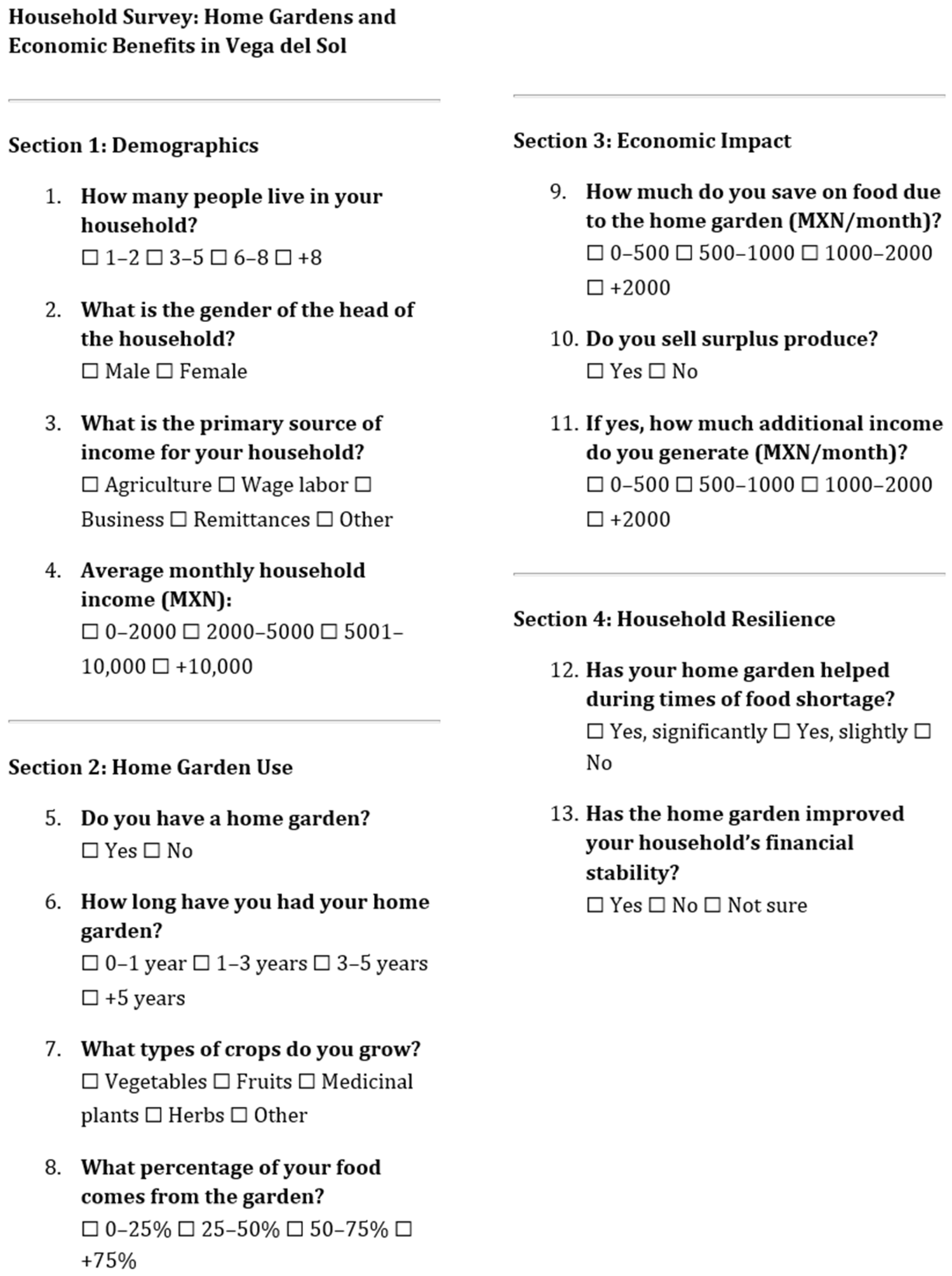

References
- Korpelainen, H. The Role of Home Gardens in Promoting Biodiversity and Food Security. Plants 2023, 12, 2473. [Google Scholar] [CrossRef]
- Montagnini, F. Homegardens of Mesoamerica: Biodiversity, Food Security, and Nutrient Management. In Tropical Homegardens. Advances in Agroforestry; Kumar, B.M., Nair, P.K.R., Eds.; Springer Netherlands: Dordrecht, The Netherlands, 2006; Volume 3, pp. 61–84. [Google Scholar] [CrossRef]
- Galhena, D.H.; Freed, R.; Maredia, K.M. Home Gardens: A Promising Approach to Enhance Household Food Security and Wellbeing. Agric. Food Secur. 2013, 2, 8. [Google Scholar] [CrossRef]
- Aguilar-Støen, M.; Moe, S.R.; Camargo-Ricalde, S.L. Home Gardens Sustain Crop Diversity and Improve Farm Resilience in Candelaria Loxicha, Oaxaca, Mexico. Hum. Ecol. 2009, 37, 55–77. [Google Scholar] [CrossRef]
- Castañeda-Navarrete, J. Homegarden Diversity and Food Security in Southern Mexico. Food Secur. 2021, 13, 669–683. [Google Scholar] [CrossRef] [PubMed]
- Niñez, V. Household Gardens: Theoretical and Policy Considerations. Agric. Syst. 1987, 23, 167–186. [Google Scholar] [CrossRef]
- Gil-García, Ó.F.; Akalin, N.; Bové, F.; Vener, S. Understanding the Mobilities of Indigenous Migrant Youth across the Americas. Soc. Sci. 2024, 13, 91. [Google Scholar] [CrossRef]
- Selod, H.; Shilpi, F. Rural-Urban Migration in Developing Countries: Lessons from the Literature. Reg. Sci. Urban Econ. 2021, 91, 103713. [Google Scholar] [CrossRef]
- Meza-Jiménez, M.D.L.; Pacheco-Cruz, R. Aspectos Socioeconómicos y de Seguridad Alimentaria En Comunidades de Muy Alta Marginación Pertenecientes a Oaxaca, México. Salud Adm. 2021, 8, 3–14. [Google Scholar]
- Calvet-Mir, L.; Riu-Bosoms, C.; González-Puente, M.; Ruiz-Mallén, I.; Reyes-García, V.; Molina, J.L. The Transmission of Home Garden Knowledge: Safeguarding Biocultural Diversity and Enhancing Social–Ecological Resilience. Soc. Nat. Resour. 2016, 29, 556–571. [Google Scholar] [CrossRef]
- de Grammont, H.C. La evolución de la producción agropecuaria en el campo mexicano: Concentración productiva, pobreza y pluriactividad. Andamios 2010, 7, 85–117. [Google Scholar] [CrossRef]
- Cruz-Yáñez, L.A. El Papel de Las Mujeres En Los Huertos Familiares. Altern. Psicol. 2016, 4, 46–60. [Google Scholar]
- Alberti-Manzanares, P.; Hernandez, M.Z.; Salcido-Ramos, B.; Real-Luna, N. Género, Economía Del Cuidado y Pago Del Trabajo Doméstico Rural En Jilotepec, Estado de México. Agric. Soc. Desarro. 2014, 11, 379–400. [Google Scholar] [CrossRef]
- Ruiz-López, P.; Pullas-Tapia, P.; Parra-Parra, C.A.; Zamora-Sánchez, R. La Doble Presencia En Las Trabajadoras Femeninas: Equilibrio Entre El Trabajo y La Vida Familiar. Rev. Comun. SEECI 2017, 1, 33–51. [Google Scholar] [CrossRef]
- Reina-Aoyama, L. Las Mujeres Zapotecas Del Istmo de Tehuantepec—México En El Siglo XIX. Available online: https://journals.openedition.org/nuevomundo/68503 (accessed on 20 August 2024).
- Lugo-Espinosa, G.; Acevedo-Ortiz, M.A.; Ortiz-Hernández, Y.D.; Aquino-Bolaños, T. Huertos Familiares y Participación Comunitaria Para La Generación de Medios de Vida Sostenibles. In Los Objetivos del Desarrollo Sostenible Versus la Pandemia de la COVID-19; Tavera-Cortés, M.E., Ed.; ASMIIA: Texcoco, México, 2023; pp. 125–138. ISBN 978-607-596-753-0. [Google Scholar]
- Castro-Apreza, I. La Participación Política de Las Mujeres Indígenas En México: Oportunidades y Desafíos. Desacatos 2011, 1, 215–221. [Google Scholar]
- El Khateeb, S.; Saber, M.; Shawket, I.M. Urban Reflections through Home Gardening; Does Gender Matter? Ain Shams Eng. J. 2023, 14, 101885. [Google Scholar] [CrossRef]
- Gripenberg, L. Social Change of an Indigenous Community: A Case Study of the Community-Based Cooperative “Millennial Women” in Oaxaca, Mexico. Bachelor’s Thesis, Lund Universitet, Lund, Sweden, 2019. [Google Scholar]
- Filimonova, N.G.; Ozerova, M.G.; Ermakova, I.N.; Miheeva, N.B. Crowdfunding as the Way of Projects Financing in Agribusiness. IOP Conf. Ser. Earth Environ. Sci. 2019, 315, 022098. [Google Scholar] [CrossRef]
- Hamlin, N.; Lake, B. An Initial Investigation into GlobalGiving’s Impact on Nonprofit Organizations. Available online: https://papers.ssrn.com/sol3/papers.cfm?abstract_id=3252703 (accessed on 24 September 2024).
- Li, Y.M.; Wu, J.D.; Hsieh, C.Y.; Liou, J.H. A Social Fundraising Mechanism for Charity Crowdfunding. Decis. Support Syst. 2020, 129, 113170. [Google Scholar] [CrossRef]
- Motylska-Kuzma, A. Crowdfunding and Sustainable Development. Sustainability 2018, 10, 4650. [Google Scholar] [CrossRef]
- Acevedo-Ortiz, M.A.; Lugo-Espinosa, G.; Ortiz-Hernández, Y.D.; Pérez-Pacheco, R. Construyendo Capacidades Locales Para Obtener Financiamiento Colectivo e Implementar Huertos Familiares En La Chinantla, Oaxaca. In Los Objetivos del Desarrollo Sostenible Versus la Pandemia de la COVID-19; Tavera-Cortés, M.E., Ed.; ASMIIA: Texcoco, México, 2023; pp. 112–124. ISBN 978-607-596-753-0. [Google Scholar]
- Iniesta, J.M.E.; Peñalver, A.J.B.; Gómez, E.H. La Financiación Del Emprendimiento Social: Estudio de La Comunicación y El Uso de Las Redes Sociales En La Plataforma de Crowdfunding “Goteo”. CIRIEC-Esp. Rev. Econ. Pública Soc. Coop. 2022, 1, 199–233. [Google Scholar] [CrossRef]
- Sánchez, W.M.; Tonon, L.B. Señalización y El Éxito de Las Campañas de Crowdfunding Latinoamericano. RETOS Rev. Cienc. Adm. Econ. 2020, 10, 99–116. [Google Scholar] [CrossRef]
- Estados Unidos Mexicanos DECRETO Por El Que Se Formula La Declaratoria de Las Zonas de Atención Prioritaria Para El Año 2023. Available online: https://dof.gob.mx/nota_detalle.php?codigo=5672639&fecha=28/11/2022#gsc.tab=0 (accessed on 30 June 2023).
- Pueblos América. Santa María Jacatepec. Vega Del Sol. Available online: https://mexico.pueblosamerica.com/i/vega-del-sol/ (accessed on 30 October 2024).
- DataMéxico Santa María Jacatepec: Economía, Empleo, Equidad, Calidad de Vida, Educación, Salud y Seguridad Pública. Data México. Available online: https://www.economia.gob.mx/datamexico/es/profile/geo/santa-maria-jacatepec (accessed on 30 October 2024).
- MIDO-Sistema de Monitoreo de Indicadores de Desempeño de Oaxaca. Available online: https://mido.oaxaca.gob.mx/home/ (accessed on 21 July 2024).
- Acevedo-Ortiz, M.A.; Lugo-Espinosa, G.; Ortiz-Hernández, Y.D.; Pérez-Pacheco, R.; Ortiz-Hernández, F.E.; Martínez-Tomás, S.H.; Tavera-Cortés, M.E. Nature-Based Solutions for Conservation and Food Sovereignty in Indigenous Communities of Oaxaca. Sustainability 2024, 16, 8151. [Google Scholar] [CrossRef]
- Cedeño-Valdiviezo, A.; Torres-Lima, P. La Chinantla Oaxaqueña: La Historia de Un Patrimonio Perdido. Diseño Soc. 2015, 1, 54–61. [Google Scholar]
- Hernández-Montiel, J.L. La Chinantla, Fuente de Agua, Fuente de Vida. Available online: https://agua.org.mx/biblioteca/la-chinantla-fuente-de-agua-fuente-de-vida-sp-5128/ (accessed on 10 October 2024).
- Berget, C.; Duran, E.; Bray, D.B. Participatory Restoration of Degraded Agricultural Areas Invaded by Bracken Fern (Pteridium Aquilinum) and Conservation in the Chinantla Region, Oaxaca, Mexico. Hum. Ecol. 2015, 43, 547–558. [Google Scholar] [CrossRef]
- Acevedo-Ortiz, M.A.; Lugo-Espinosa, G.; Ortiz-Hernández, Y.D. Percepciones Comunitarias Sobre Mecanismos de Conservación de Recursos Naturales Bajo Un Enfoque Paisajístico En Tres Ejidos de La Chinantla, Oaxaca. In Aproximaciones Teórico-Metodológicas para el Análisis Territorial y el Desarrollo Regional Sostenible; Martínez-Pellegrini, S.E., Sarmiento-Franco, J.F., Valles-Aragón, M.C., Eds.; Recuperación transformadora de los territorios con equidad y sostenibilidad; Universidad Nacional Autónoma de México, Instituto de Investigaciones Económicas y Asociación Mexicana de Ciencias para el Desarrollo Regional: Ciudad de México, Mexico, 2021; Volume 1, pp. 1–18. ISBN 978-607-30-5332-7. [Google Scholar]
- Lugo-Espinosa, G.; Acevedo-Ortiz, M.A.; Aquino-Bolaños, T.; Ortiz-Hernández, Y.D.; Ortiz-Hernández, F.E.; Pérez-Pacheco, R.; López-Cruz, J.Y. Cultural Heritage, Migration, and Land Use Transformation in San José Chiltepec, Oaxaca. Land 2024, 13, 1658. [Google Scholar] [CrossRef]
- Evso Estadísticas de Vega Del Sol, Santa María Jacatepec, Oaxaca. Available online: https://mexico.pueblosamerica.com/i/vega-del-sol/ (accessed on 30 June 2023).
- Matas, A. Diseño Del Formato de Escalas Tipo Likert: Un Estado de La Cuestión. Rev. Electron. Investig. Educ. 2018, 20, 38–47. [Google Scholar] [CrossRef]
- Aguilar-Estrada, A.E.; Caamal-Cauich, I.; Barrios-Puente, G.; Ortiz-Rosales, M.A. ¿Hambre En México? Una Alternativa Metodológica Para Medir Seguridad Alimentaria. Estud. Soc. Rev. Aliment. Contemp. Desarro. Reg. 2019, 29, 2–26. [Google Scholar] [CrossRef]
- Shamah-Levy, T.; Mundo-Rosas, V.; Flores-De la Vega, M.M.; Luiselli-Fernández, C. Food Security Governance in Mexico: How Can It Be Improved? Glob. Food Secur. 2017, 14, 73–78. [Google Scholar] [CrossRef]
- Home Gardens for 100 Families, Oaxaca, Mexico. Available online: https://www.objective.earth/Home_Gardens_for_100_Families,_Oaxaca,_Mexico/ (accessed on 30 October 2024).
- Acevedo-Ortiz, M.A.; Lugo-Espinosa, G.; Ortiz-Hernández, Y.D.; Ortiz-Hernández, F.E. Herramientas Metodológicas En Procesos Participativos En Comunidades Rurales Para La Conservación de Recursos Naturales; Tavera-Cortés, M.E., Ed.; Editorial ASMIIA: Texcoco, Estado de México, 2022; pp. 93–106. ISBN 978-607-99921-0-1. [Google Scholar]
- González, B.; Peña, M.; Rincón, N.; Bustillo, L.; Urdaneta, F. Formulación de Lineamientos Estratégicos Para El Desarrollo Rural, Basado En Una Metodología Participativa. Rev. Fac. Agron. 2004, 21, 398–414. [Google Scholar]
- Jayachandran, S. Social Norms as a Barrier to Women’s Employment in Developing Countries. IMF Econ. Rev. 2021, 69, 576–595. [Google Scholar] [CrossRef]
- Anand, M.; Mecagni, A.; Piracha, M. Practical Tools and Frameworks for Measuring Agency in Women’s Economic Empowerment; SEEP Network: Camberwell, Australia, 2019. [Google Scholar]
- Cronkleton, P.; Evans, K.; Addoah, T.; Dumont, E.S.; Zida, M.; Djoudi, H. Using Participatory Approaches to Enhance Women’s Engagement in Natural Resource Management in Northern Ghana. Sustainability 2021, 13, 7072. [Google Scholar] [CrossRef]
- Kirkwood, E.K.; Dibley, M.J.; Khatun, W.; Ara, G.; Khanam, M.; Bokshi, A.; Li, M.; Alam, N.A. Can a Combined Agriculture and Nutrition Behaviour Change Intervention Improve Women’s Empowerment? A Mixed Methods Feasibility Study in Rural Bangladesh. Qual. Rep. 2022, 27, 2905–2922. [Google Scholar] [CrossRef]
- Alesina, A.; Giuliano, P.; Nunn, N. On the Origins of Gender Roles: Women and the Plough. Q. J. Econ. 2013, 128, 469–530. [Google Scholar] [CrossRef]
- Calvet-Mir, L.; March, H.; Corbacho-Monné, D.; Gómez-Baggethun, E.; Reyes-García, V. Home Garden Ecosystem Services Valuation through a Gender Lens: A Case Study in the Catalan Pyrenees. Sustainability 2016, 8, 718. [Google Scholar] [CrossRef]
- Howard, P.L. Gender and Social Dynamics in Swidden and Homegardens in Latin America. In Tropical Homegardens. Advances in Agroforestry; Kumar, B.M., Nair, P.K.R., Eds.; Springer Netherlands: Dordrecht, The Netherlands, 2006; Volume 3, pp. 159–182. [Google Scholar] [CrossRef]
- EcoLogic Home Gardens for 200 Families, Oaxaca, Mexico. Available online: https://www.globalgiving.org/projects/home-gardens-protecting-forests-in-oaxaca-mexico/ (accessed on 20 September 2024).
- Patalagsa, M.A.; Schreinemachers, P.; Begum, S.; Begum, S. Sowing Seeds of Empowerment: Effect of Women’s Home Garden Training in Bangladesh. Agric. Food Secur. 2015, 4, 24. [Google Scholar] [CrossRef]
- Schreinemachers, P.; Patalagsa, M.A.; Uddin, N. Impact and Cost-Effectiveness of Women’s Training in Home Gardening and Nutrition in Bangladesh. J. Dev. Eff. 2016, 8, 473–488. [Google Scholar] [CrossRef]
- Syhre, J.-A.; Brückner, M. The Garden Has Improved My Life: Agency and Food Sovereignty of Women in Urban Agriculture in Nairobi. In Feminist Political Ecology and the Economics of Care; Routledge: London, UK, 2018; pp. 189–210. [Google Scholar] [CrossRef]
- Mekonnen, A.; Mekuria, A.; Zemede, A. The Role of Homegardens for in Situ Conservation of Plant Biodiversity in Holeta Town, Oromia National Regional State, Ethiopia. Int. J. Biodivers. Conserv. 2014, 6, 8–16. [Google Scholar] [CrossRef]
- Santos, M.; Moreira, H.; Cabral, J.A.; Gabriel, R.; Teixeira, A.; Bastos, R.; Aires, A. Contribution of Home Gardens to Sustainable Development: Perspectives from a Supported Opinion Essay. Int. J. Environ. Res. Public Health 2022, 19, 13715. [Google Scholar] [CrossRef] [PubMed]
- Fárez-Jiménez, M.-Á.; Cañizares-Medina, A.E.; Tapia-Segarra, J.I.; Robalino-Peña, E.M. Organización Comunitaria En La Producción de Huertos. Cienciamatria 2022, 8, 2168–2176. [Google Scholar] [CrossRef]
- Duflo, E. Women Empowerment and Economic Development. J. Econ. Lit. 2012, 50, 1051–1079. [Google Scholar] [CrossRef]
- Lugo Espinosa, G.; Acevedo Ortiz, M.A.; Ortiz Hernández, Y.D. Conservación de semilla criolla y control biológico, resguardo del patrimonio biocultural de la Chinantla Oaxaca. In Nuevas Territorialidades-gestión de los Territorios y Recursos Naturales con Sustentabilidad Ambiental; Sarmiento-Franco, J.F., Ed.; UNAM-AMECIDER: Ciudad de México, México, 2023; Volume 1, pp. 221–236. ISBN 978-607-30-8314-0. [Google Scholar]
- Salazar, L. Semillas Para La Seguridad Alimentaria En América Latina y El Caribe (ALC); Banco Interamericano de Desarrollo: Washington, DC, USA, 2023. [Google Scholar]
- Darby, K.; Hinton, T.; Torre, J. The Motivations and Needs of Rural, Low-Income Household Food Gardeners. J. Agric. Food Sys. Community Dev. 2020, 9, 55–69. [Google Scholar] [CrossRef]
- Molina, C.L. La Familia Ante La Pandemia Del COVID-19. Ius Prax. 2020, 23–29. [Google Scholar] [CrossRef]
- Haspolat, G. The Usage of Ultra Dilutions in Agriculture. Allg. Homöopath. Ztg. 2023, 268, 4–10. [Google Scholar] [CrossRef]
- Kumar, S.; Dhruw, S.; Porte, D.P.; Verma, N.K.; Kashyap, P.; Tiwari, R.K.S.; Bhattacharyya, A. Plant Extracts as an Alternative to Synthetic Chemicals: A Review. Biol. Forum–Int. J. 2023, 15, 24–29. [Google Scholar]
- Prieto-Méndez, J.; Prieto-García, F.; Hernández-Pérez, A.D.; Quijada-Morales, L.M.; Aquino-Torres, E.; Acevedo-Sandoval, O.A. Agrohomeopathy: New Tool to Improve Soils, Crops and Plant Protection against Various Stress Conditions. Review. Hortic. Argent. 2021, 40, 43. [Google Scholar]
- Foley, J.A.; Ramankutty, N.; Brauman, K.A.; Cassidy, E.S.; Gerber, J.S.; Johnston, M.; Mueller, N.D.; O’Connell, C.; Ray, D.K.; West, P.C.; et al. Solutions for a Cultivated Planet. Nature 2011, 478, 337–342. [Google Scholar] [CrossRef]
- Yang, Q.; Al Mamun, A.; Naznen, F.; Masud, M.M. Adoption of Conservative Agricultural Practices among Rural Chinese Farmers. Humanit. Soc. Sci. Commun. 2024, 11, 1–14. [Google Scholar] [CrossRef]
- Regner, T.; Crosetto, P. The Long-Term Effects of Self Pledging in Reward Crowdfunding. Technol. Forecast. Soc. Chang. 2021, 165, 120514. [Google Scholar] [CrossRef]
- Borrero-Domínguez, C.; Cordón-Lagares, E.; Hernández-Garrido, R. Crowdfunding Para Organizaciones de Economía Social: Factores de Éxito. REVESCO. Rev. Estud. Coop. 2022, 140, 79940. [Google Scholar] [CrossRef]
- Ljumović, I.; Hanić, A.; Kovačević, V. The Role of Reward-Based Crowdfunding in Farm Financing: What Characterises Successful Campaign? Ekon. Poljopr. 2021, 68, 773–788. [Google Scholar] [CrossRef]
- Greenberg, M.D.; Hui, J.; Gerber, E. Crowdfunding: A Resource Exchange Perspective. In Proceedings of the CHI ’13 Extended Abstracts on Human Factors in Computing Systems, Paris, France, 27 April–2 May 2013; Association for Computing Machinery: New York, NY, USA, 2013; pp. 883–888. [Google Scholar]
- Behrendt, G.; Peter, S.; Sterly, S.; Häring, A.M. Community Financing for Sustainable Food and Farming: A Proximity Perspective. Agric. Hum. Values 2022, 39, 1063–1075. [Google Scholar] [CrossRef]
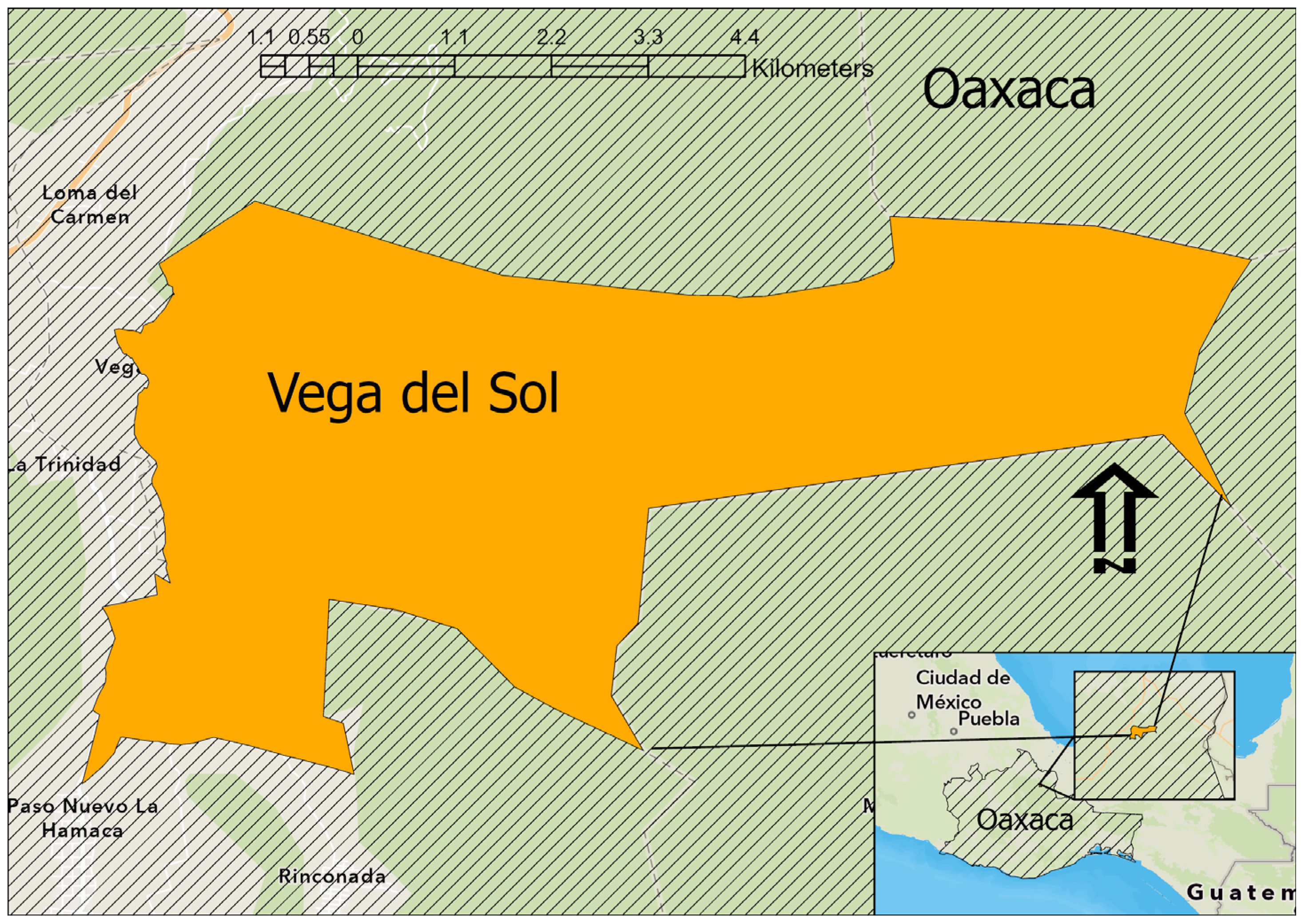
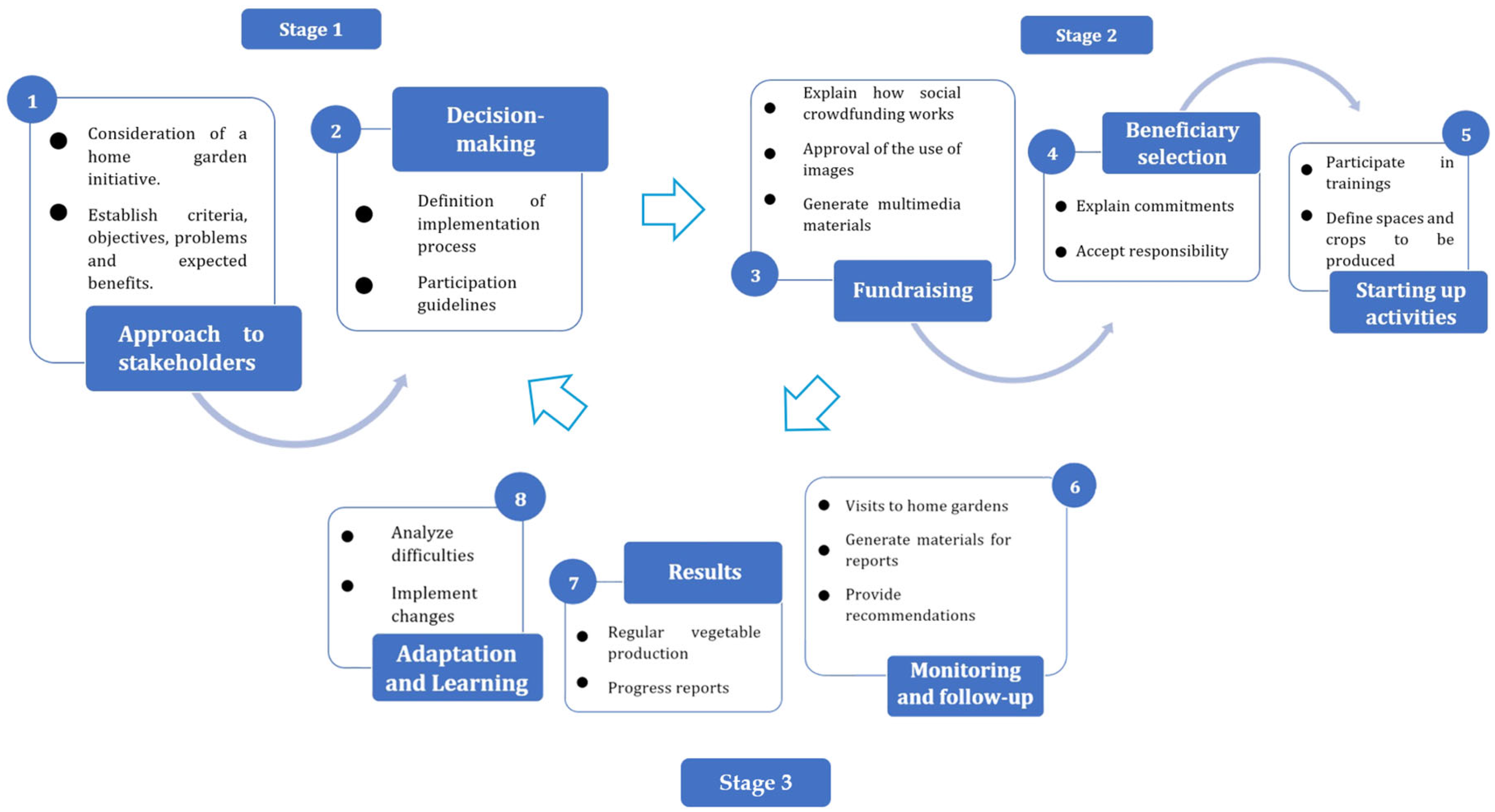

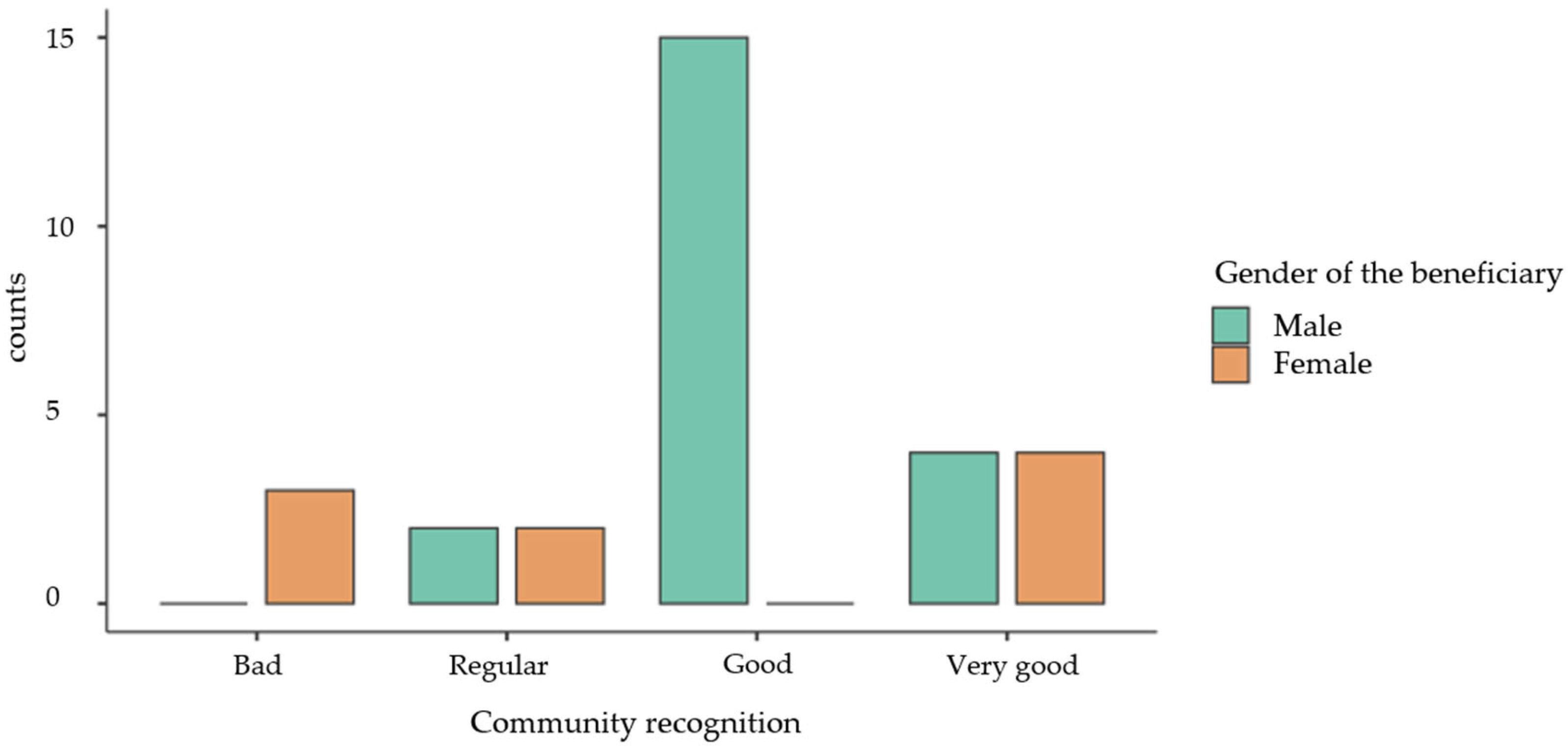
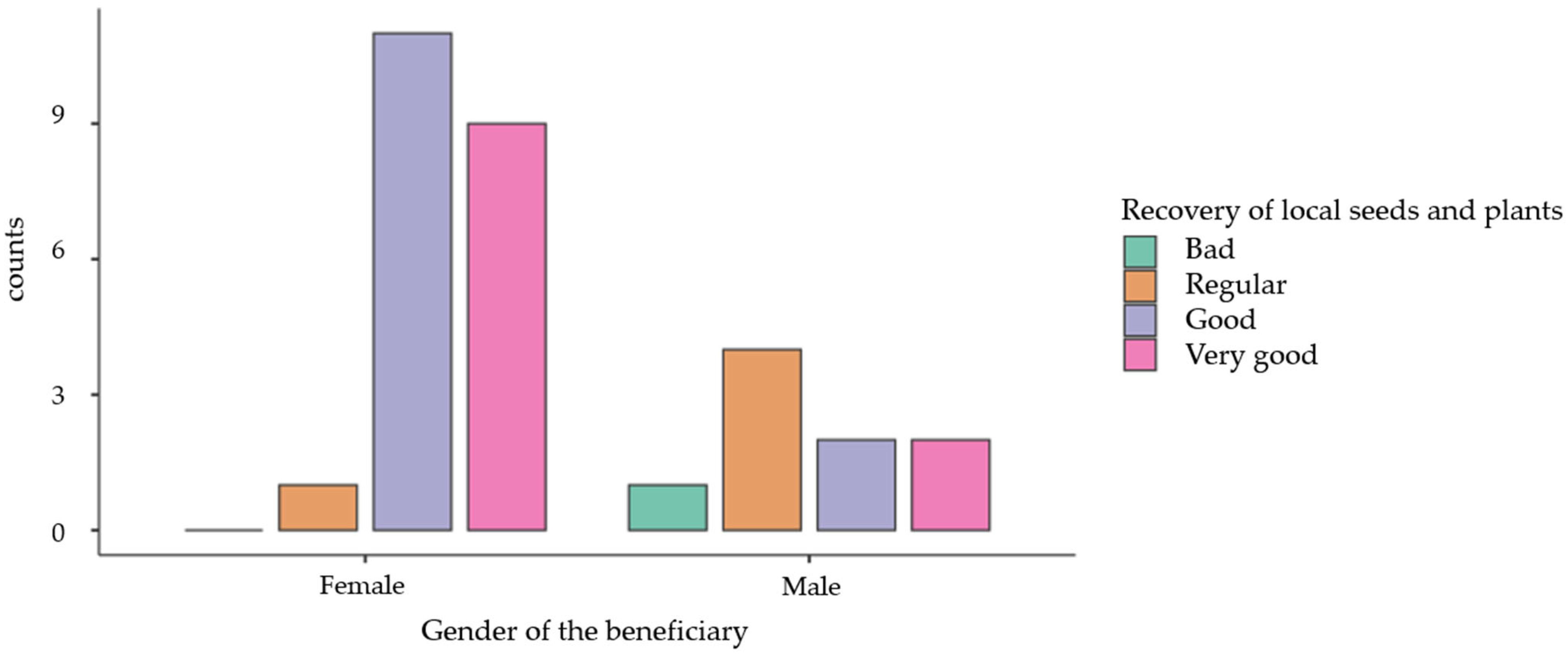
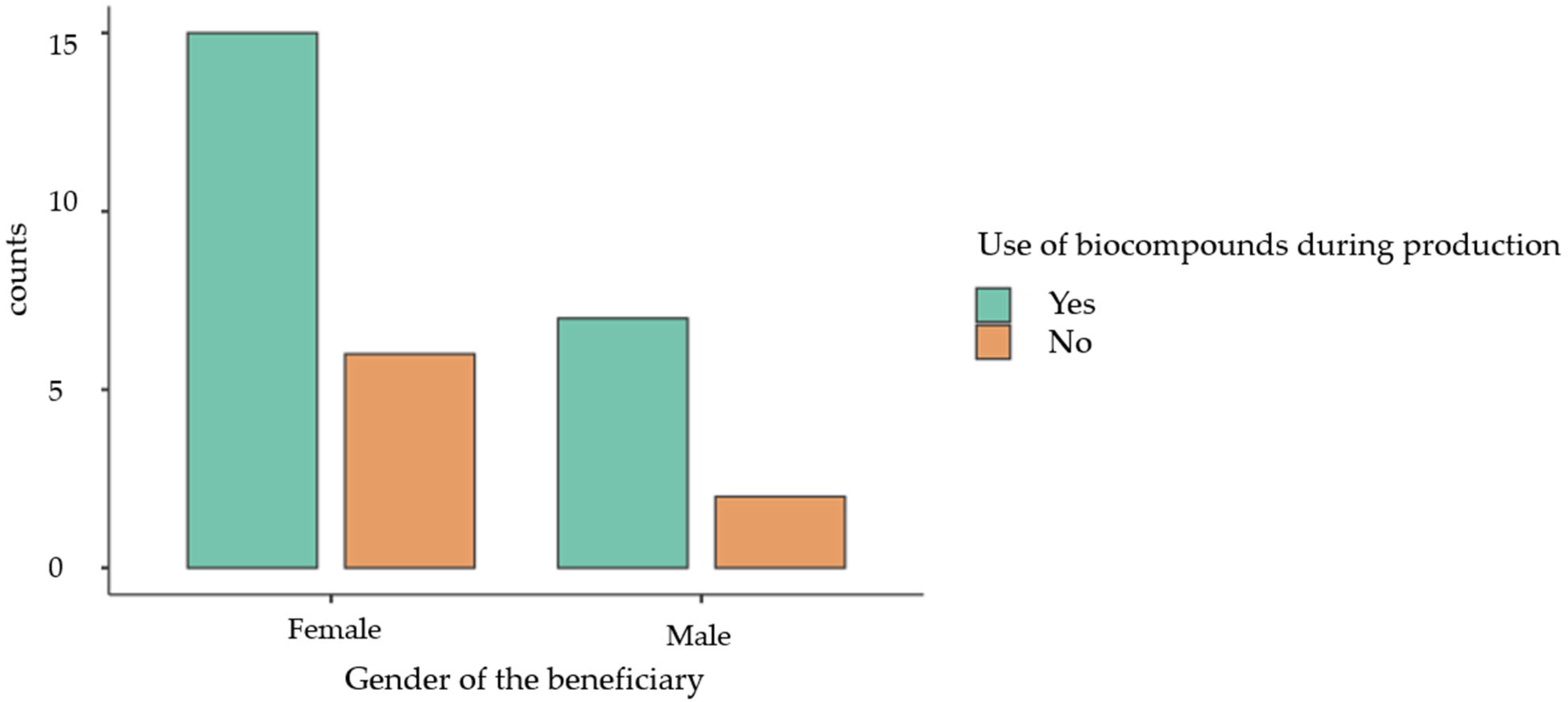
| Gender of the Beneficiary | Initial Perception | Counts | Percentage of Total (%) |
|---|---|---|---|
| Female (21) | Very bad | 2 | 9.52 |
| Bad | 6 | 28.57 | |
| Regular | 6 | 28.57 | |
| Good | 5 | 23.81 | |
| Very good | 2 | 9.52 | |
| Male (9) | Very bad | 1 | 11.11 |
| Bad | 1 | 11.11 | |
| Regular | 1 | 11.11 | |
| Good | 6 | 66.67 | |
| Very good | 0 | 0 |
| Measure | Level | HH Count Over * | Percentage of Total (%) |
|---|---|---|---|
| Availability of goods | Bad | 3 | 10 |
| Regular | 7 | 23.33 | |
| Good | 13 | 42.33 | |
| Very good | 7 | 23.33 | |
| Access to Healthy food | Bad | 3 | 10 |
| Regular | 7 | 23.33 | |
| Good | 14 | 46.67 | |
| Very good | 6 | 20 | |
| Savings due to production | Very bad | 4 | 13.33 |
| Bad | 3 | 10 | |
| Regular | 9 | 30 | |
| Good | 14 | 46.67 | |
| Harvest obtained during the cycle | Yes | 23 | 76.67 |
| No | 7 | 23.33 |
| HH | ANIH * (MXN $) | MFEH * (MXN $) | MVEH * (MXN $) | IIH * (MXN $) | SFPI * (MXN $) | ISSL * (MXN $) | CIHI * (MXN $) |
|---|---|---|---|---|---|---|---|
| 1 | 11,236 | 10,716 | 1530 | 1400 | 130 | 347 | 477 |
| 2 | 11,008 | 10,644 | 1479 | 1400 | 79 | 438 | 517 |
| 3 | 10,913 | 10,356 | 1492 | 1400 | 92 | 313 | 405 |
| 4 | 10,947 | 9804 | 1582 | 1400 | 182 | 427 | 609 |
| 5 | 10,800 | 9612 | 1384 | 1400 | −16 | 136 | 120 |
| 6 | 10,410 | 9828 | 1600 | 1400 | 200 | 274 | 474 |
| 7 | 11,389 | 10,098 | 1331 | 1400 | −69 | 256 | 187 |
| 8 | 10,397 | 10,788 | 1306 | 1400 | −94 | 265 | 171 |
| 9 | 10,009 | 9750 | 1555 | 1400 | 155 | - | 155 |
| 10 | 10,156 | 9816 | 1393 | 1400 | −7 | 153 | 146 |
| 11 | 11,068 | 10,188 | 1561 | 1400 | 161 | 266 | 427 |
| 12 | 9987 | 10,122 | 1444 | 1400 | 44 | 458 | 502 |
| 13 | 10,458 | 10,776 | 1338 | 1400 | −62 | - | −62 |
| 14 | 11,449 | 9804 | 1593 | 1400 | 193 | - | 193 |
| 15 | 11,192 | 9780 | 1413 | 1400 | 13 | 378 | 391 |
| 16 | 11,005 | 10,104 | 1491 | 1400 | 91 | 399 | 490 |
| 17 | 11,468 | 9936 | 1368 | 1400 | −32 | 352 | 320 |
| 18 | 10,073 | 9810 | 1419 | 1400 | 19 | 308 | 327 |
| 19 | 10,009 | 10,596 | 1439 | 1400 | 39 | - | 39 |
| 20 | 11,034 | 10,512 | 1320 | 1400 | −80 | 426 | 346 |
| 21 | 10,766 | 10,188 | 1465 | 1400 | 65 | 381 | 446 |
| 22 | 10,765 | 10,122 | 1516 | 1400 | 116 | 243 | 359 |
| 23 | 11,472 | 10,140 | 1457 | 1400 | 57 | - | 57 |
| 24 | 10,508 | 9984 | 1534 | 1400 | 134 | 428 | 562 |
| 25 | 10,867 | 9732 | 1357 | 1400 | −43 | 425 | 382 |
| 26 | 10,004 | 10,614 | 1475 | 1400 | 75 | 257 | 332 |
| 27 | 10,265 | 9762 | 1339 | 1400 | −61 | - | −61 |
| 28 | 11,016 | 10,416 | 1412 | 1400 | 12 | - | 12 |
| 29 | 10,129 | 10,308 | 1436 | 1400 | 36 | 250 | 286 |
| 30 | 10,837 | 10,242 | 1507 | 1400 | 107 | - | 107 |
| Category | Common Name | Scientific Name | Plant Number |
|---|---|---|---|
| Fruit trees | Citrus fruits (sweet lemon and sweet orange) | Citrus spp. | +++ |
| Citrus (sour orange) | Citrus sp. | ++ | |
| Mango | Mangifera indica | ++ | |
| Jinicuil | Inga jinicuil | ++ | |
| Guava | Psidium guajava | ++ | |
| Papaya | Carica papaya | + | |
| Soursop | Annona muricata | + | |
| Mamey | Pouteria sapota | + | |
| Anona | Annona reticulata | + | |
| Tamarind | Tamarindus indica | + | |
| Mexican avocado | Persea sp. | ++ | |
| Plum | Spondia | ++ | |
| Carambola | Averrhoa carambola | + | |
| Lychee | Litchi chinensis | + | |
| Pink Poma | Syzygium jambos | + | |
| White cocoa | Theobroma bicolor | + | |
| Cocoa | Theobroma cacao | + | |
| Purple plantain | acuminata/balbisiana | + | |
| Annatto | Bixa orellana | + | |
| Coffee | Coffea arabica Coffea robusta | + | |
| Posole leaf | Calathea lutea | + | |
| Jicara | Crescentia cujete | + | |
| Chikal | Lagenaria siceraria | + | |
| Plants (edible or medicinal) | Blackberry herb | Solanum nigrescens | ++ |
| Fitolaca | Phytolacca icosandra | + | |
| Smells at night | Cestrum nocturnum | + | |
| Quintonil, white quelite | Amaranthus hybridus | ++ | |
| Quelite de venado | Ipomea sp. | + | |
| Chipil or Chepil | Crotalaria sp. | ++ | |
| Purslane | Portulaca oleracea | + | |
| Chayote | Sechium edule | + | |
| Pumpkin | Cucurbita moschata | + | |
| Passion fruit or Palau | Passiflora edulis | + | |
| Watermelon | Citrullus lanatus | + | |
| Coconut | Cocos nucifera | + | |
| Tepejilote | Chameadora tepijilote | + | |
| Huasmole, Huele mole | Renealmia alpinia | + | |
| Nopal tres lobos or pitaya | Hylocereus undatus | + | |
| Tomato | Solanum lycopersicon | + | |
| Guaje | Luecaena esculenta | + | |
| Acuyo or hierba santa | Piper auritum | + | |
| Mint or spearmint | Mentha viridis | + | |
| Oregano orejón or vaporub plant | Ocinum sp. | ++ | |
| Chile | Capsicum annuum | + | |
| Chives | Allium sp. | + | |
| Epazote | Dysphania ambrosioides | + | |
| Basil | Ocimum basilicum | + | |
| Cilantro de monte or bull’s coriander | Eryngium foetidum | + | |
| Cinnamon | Cinnamomum verum | + | |
| Coriander | Coriandrum sativum | + | |
| Grains | Corn | Zea mays | +++ |
| Beans | Phaseolus coccineus Phaseolus vulgaris | +++ | |
| Roots | Malanga | Colocasia esculenta | ++ |
| Sweet potato | Ipomea batata | ++ | |
| Cassava | Manihot esculenta | ++ | |
| Jicama | Pachyrhizus erosus | + |
| Gender of the Beneficiary | Final Perception | Counts | Percentage of Total (%) |
|---|---|---|---|
| Female (21) | Bad | 1 | 4.76 |
| Regular | 8 | 38.10 | |
| Good | 10 | 47.62 | |
| Very good | 2 | 9.52 | |
| Male (9) | Bad | 0 | 0 |
| Regular | 1 | 11.11 | |
| Good | 3 | 33.33 | |
| Very good | 5 | 55.56 |
Disclaimer/Publisher’s Note: The statements, opinions and data contained in all publications are solely those of the individual author(s) and contributor(s) and not of MDPI and/or the editor(s). MDPI and/or the editor(s) disclaim responsibility for any injury to people or property resulting from any ideas, methods, instructions or products referred to in the content. |
© 2024 by the authors. Licensee MDPI, Basel, Switzerland. This article is an open access article distributed under the terms and conditions of the Creative Commons Attribution (CC BY) license (https://creativecommons.org/licenses/by/4.0/).
Share and Cite
Acevedo-Ortiz, M.A.; Lugo-Espinosa, G.; Ortiz-Hernández, Y.D.; Pérez-Pacheco, R.; Ortiz-Hernández, F.E.; Granados-Echegoyen, C.A. Women’s Leadership in Sustainable Agriculture: Preserving Traditional Knowledge Through Home Gardens in Santa Maria Jacatepec, Oaxaca. Sustainability 2024, 16, 9513. https://doi.org/10.3390/su16219513
Acevedo-Ortiz MA, Lugo-Espinosa G, Ortiz-Hernández YD, Pérez-Pacheco R, Ortiz-Hernández FE, Granados-Echegoyen CA. Women’s Leadership in Sustainable Agriculture: Preserving Traditional Knowledge Through Home Gardens in Santa Maria Jacatepec, Oaxaca. Sustainability. 2024; 16(21):9513. https://doi.org/10.3390/su16219513
Chicago/Turabian StyleAcevedo-Ortiz, Marco Aurelio, Gema Lugo-Espinosa, Yolanda Donají Ortiz-Hernández, Rafael Pérez-Pacheco, Fernando Elí Ortiz-Hernández, and Carlos Alejandro Granados-Echegoyen. 2024. "Women’s Leadership in Sustainable Agriculture: Preserving Traditional Knowledge Through Home Gardens in Santa Maria Jacatepec, Oaxaca" Sustainability 16, no. 21: 9513. https://doi.org/10.3390/su16219513
APA StyleAcevedo-Ortiz, M. A., Lugo-Espinosa, G., Ortiz-Hernández, Y. D., Pérez-Pacheco, R., Ortiz-Hernández, F. E., & Granados-Echegoyen, C. A. (2024). Women’s Leadership in Sustainable Agriculture: Preserving Traditional Knowledge Through Home Gardens in Santa Maria Jacatepec, Oaxaca. Sustainability, 16(21), 9513. https://doi.org/10.3390/su16219513








